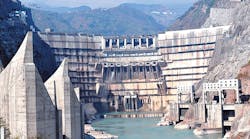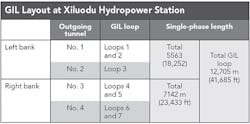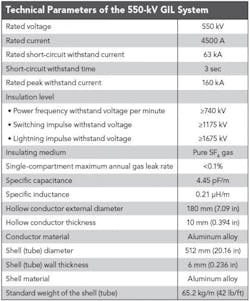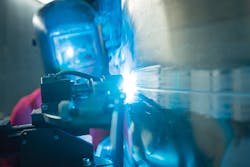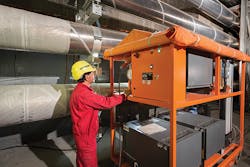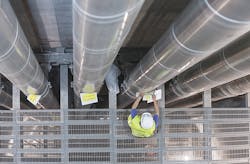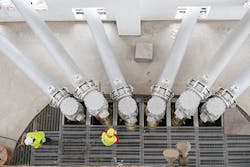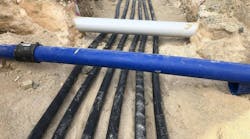In 2014, China Three Gorges Corp. completed construction of the Xiluodu hydropower station on the main stream of the Jinsha River. In total, seven 550-kV gas-insulated line (GIL) circuits were installed on the two banks of the dam, making it the largest GIL installation in the world.
Located on the border of Leibo County, Sichuan Province, and Yongshan County, Yunnan Province, this hydropower station is equipped with 18 770-MW turbine generator units. Two generation halls are in parallel with the transformer chambers and the tunnels. The tunnels with the 550-kV GILs are positioned immediately above the main transformer chambers. The 550-kV tunnels pass the vertical shafts constructed to accommodate the GILs en route to ground level. These shafts measure 475 m (1,558 ft) on the left bank and 480 m (1,574 ft) on the right bank of the Xiluodu Dam. GILs were selected after full consideration of the excessive length and complexity of the power circuit route, namely the vertical shafts and tunnels as well as the high current-carrying capacity required.
GIL Technical and Structural Characteristics
The technical characteristics and service performance of the Siemens 550-kV GIL system fully satisfy the demanding design and construction features of this project and comply with relevant regulations and criteria.
Silicon rubber composite bushings are used to support the conductor within the shell as it is easy to install, maintain and able to withstand earthquakes. The partial discharge monitoring system employed for the GILs is based on ultrahigh-frequency detection technology.
To prevent reclosure of a GIL in the event of a short-circuit fault, the protection current transformers are located in the transmission system substation. The short-circuit fault condition of the GILs is detected by current transformers installed in the gas-insulated substation (GIS) between the GIL and the GIS connection.
Design Features of the GIL Installation
The weight of the GIL is supported by fixed and sliding supports designed to withstand the expansion and contraction of the GIL shell. The sections of the shell are welded together on site, and the phase conductors in both the horizontal and vertical sections are connected using flanges at curved sections.
To facilitate future maintenance and repairs to the phase conductors, platforms have been installed beneath the welded joints located at the end of each shell section every 11.5 m (36 ft).
To ensure safe operation, the GIL is divided into several independent gas chambers. The GILs at the Xiluodu hydropower station are composed of seven chambers: three for outgoing field, two for the upper vertical shaft and two for the lower vertical shaft. The longest chamber length is 134 m (440 ft), and every chamber has a temperature compensation density relay equipped with a pressure gauge on both ends.
The GIL Earthing System
The distance between two earthing points is specified to be within 200 m (656 ft). In the bus bar shell, multipoint earthing and earthing points are located at the three-phase joints. Short earthing jump wires are installed on both ends of the shell’s expansion joints.
Major Construction Features
The vertical sections of the GILs are designed with basin-type insulators to support the fixed conductor, and column-type supporting insulators have been installed in the horizontal sections. The particle collector is installed inside the horizontal section to collect any conductive particles inside the tube.
To support the weight of the GILs in the vertical shaft and provide free movement of the conductors to allow for thermal expansion and contraction, fixed and sliding supports have been used. The fixed supporting points of the GILs are set right in the middle and bottom sections of the vertical shaft, and the sliding support points are positioned at every standard section.
Additionally, in case of shell or conductor distortion caused by thermal expansion or contraction, sliding conductor contacts and universal expansion joints with hinges are installed.
GIL System Installation
The GIL components were shipped to the preassembly workshop at the Xiluodu hydropower station construction site, and staff from Siemens and China Three Gorges Corp. installed the GILs. After assembly into standard section components, they were then transported to the bottom of the vertical shaft for welding at the fixed welding workstation. Following welding, the assembled parts were hoisted by an overhead crane into position and the procedures were repeated until the last GIL section was installed.
The GIL parts were preassembled into standard section components in the workshop, which provided an absolute dust-free environment. A temporary preassembly workshop was used for inspection, mechanical treatment and tube unit installation. All components required inspection, mechanical treatment such as grinding welded joints, followed by conductor and shell cleaning. The complete conductor and shell assembly was then protected by end covers to avoid pollution during transportation.
Welding Process
The bus bar was assembled by shell welding, using an on-site welding platform that included a 100% ultrasonic flaw-detection procedure, as only zero flaws signify satisfactory completion of welding. In view of the demanding standards required by this process, Siemens’ staff was responsible for the GIL welding and flaw-detection examination process. An argon tungsten-arc welding machine was used for the bus bar welding; an efficient target of three to four welding joints per day corresponded to completion of one section of bus bar installation.
The on-site welding required a high-standard environment so the construction site was sealed and separated from all other areas of management and installation. Multilayered dust-preventing partitions were erected, and several air purifiers designed for removing dust and dehydrating were installed in this special welding environment.
Hoisting the GIL
In conjunction with the bus bar welding work, one 2.5-ton crane and one 20-ton overhead crane were sited at the top of the vertical shaft. The 2.5-ton overhead crane hoisted the bus bar onto the welding platform; then the entire bus bar section was lifted by the 20-ton overhead crane to make room for the next section’s installation.
Gas Work
Following completion of the welding work, the GIL installation then moved on to the gas inflation, which included three steps: a pressure test, creation of a vacuum and gasification. The pressure test used dry air that was 1.1 times the rated pressure for a period of three minutes. The test was deemed satisfactory if the pressure remained unchanged. The pressure in the bus bar tube was then reduced to about 1 mbar for an hour before filling the bus bar with SF6 at rated pressure.
A new technology called gas sweeping was used to clean unwelcome dust inside the bus bar during construction. This procedure followed two steps. The first step is to fill the compartment with dry air at approximately the rated pressure, switching on the lower valve to let in the air to blow from bottom to top. The second step is to fill the compartment with dry air at approximately the rated pressure, switching on both the upper and lower valves to let the airflow purge all unwelcome dust.
Electrical Tests
The Siemens manufacturing process included preassembly on site so the only factory acceptance test was the alternating-current (ac) withstand-voltage test for the insulators. Therefore, it was important after the GIL circuits were completely installed to do the ac withstand-voltage test twice. The ac withstand-voltage test for the GILs required sophisticated purification of the insulating medium, critical timing of the voltage gradient and the amount of time in which the phases of the GILs were overstressed.
During the on-site testing, dust inside the bus bar resulted in a flashover during the voltage ascent process in a vertical shaft section. Following remedial action, all the phases of the GILs passed the ac withstand-voltage test.
The conventional on-site tests for the GILs included the conductive resistance test, tightness test, moisture content and air content measurements of the SF6, relays, pressure meter and pressure-operated valve checking, current transformer accuracy calibration and more.
Lessons Learned
China Three Gorges analyzed the abnormal situations that occurred during installation and testing, and, as a result of its findings, learned several lessons.
The GIL installation was directly influenced by the quality of the civil engineering standards. The embedded parts should be accurately placed during the civil construction, and complete waterproof conditions are required inside the vertical shaft.
The construction preparation workload was very demanding and labor intensive. These tasks included building a temporary preassembly workshop, setting up the welding platform and welding dustproof enclosure, securing the availability of large hoisting equipment, doing the early negotiations and monitoring the working progress.
The on-site preassembly processes had a direct connection with the quality of products and should have been conducted in strict accordance with specialized technologies. For example, when grinding the welding junction oxide layer, the protection and insulator cleaning should have been even more thorough to avoid aluminum spoil from dropping into the gas chamber and affecting the insulating property of the GIL.
The welding work required an environmentally demanding tent that should have been positioned at the construction site. Also, the required tent should have been positioned to separate the GIL installation area from the outside.
On completion of the installation work, every gas chamber should have been purged to remove all dust to ensure the integrity of the insulating properties.
Because of the height difference of the vertical shafts, the natural convection inside was influenced by the local climate and the air direction that differed between fine weather and rainy days.
The supporting ring was the major component in preventing welding slags from dropping into the gas chamber to ensure the GIL circuits are installed properly. Moreover, any deviation in the roundness of the supporting ring should be well handled to avoid particles from welding procedure to enter the gas chamber during long-term operation. Hence, these particles adversely affect the insulating properties of the GILs.
Wu Zhongping ([email protected]) is a professor-level senior engineer who has been engaged long term in hydropower station electrical equipment contracts, purchasing, installation and commissioning.
Liu Kun ([email protected]) is a senior engineer who has been engaged in hydropower station electrical equipment, contract bidding, purchasing, installation and commissioning since she joined the China Three Gorges Corp.
Lei Xiao ([email protected]) is a senior engineer engaged in hydropower station electrical equipment, tender evaluation and purchasing.
Wu Qiong ([email protected]) is an engineer engaged in hydropower station electrical equipment, installation and commissioning.
Li Juan ([email protected]) is an engineer engaged in hydropower station electrical equipment bidding and purchasing.
Wang Lei ([email protected]) is an engineering assistant engaged in hydropower station electrical equipment and contract management.
